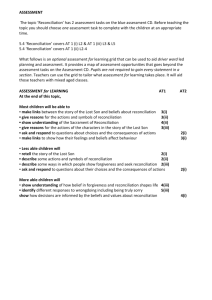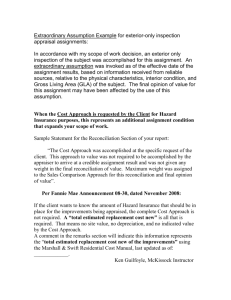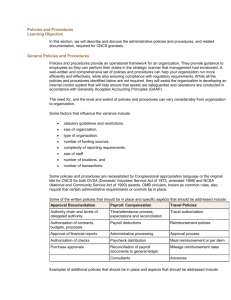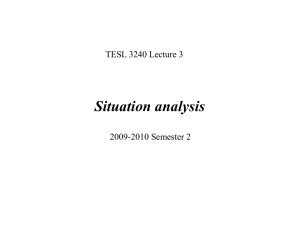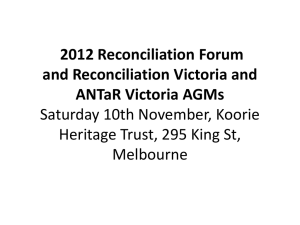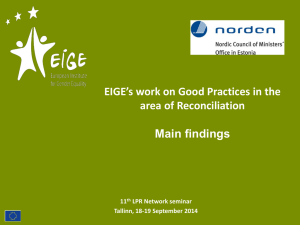Change of the Conflictive Ethos
advertisement
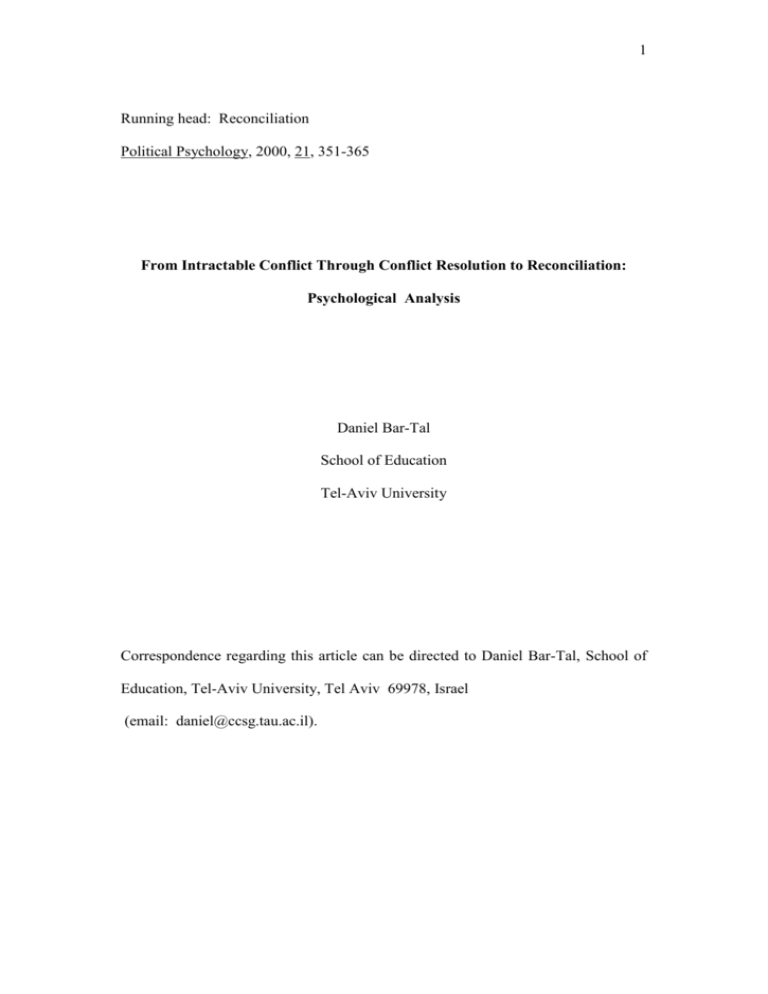
1 Running head: Reconciliation Political Psychology, 2000, 21, 351-365 From Intractable Conflict Through Conflict Resolution to Reconciliation: Psychological Analysis Daniel Bar-Tal School of Education Tel-Aviv University Correspondence regarding this article can be directed to Daniel Bar-Tal, School of Education, Tel-Aviv University, Tel Aviv 69978, Israel (email: daniel@ccsg.tau.ac.il). 2 Abstract Intractable intergroup conflicts require the formation of conflictive ethos which enable a society to adapt to the conflict situation, survive the stressful period and struggle successfully with the adversary. Resolution of intractable conflicts pertains to elimination of the perceived incompatibility between the opposing parties through negotiation by their representatives. But, formal termination of a conflict, through conflict resolution, is only part of the long term reconciliation process, which requires formation of peaceful relations based on mutual trust and acceptance, cooperation and consideration of mutual needs. Psychological aspect of reconciliation requires societal-cultural change of the conflictive ethos, especially of societal beliefs about goals, about the adversary group, about own group, about intergroup relation with the former adversary and about nature of peace. In essence, psychological reconciliation requires an evolvement of ethos of peace. The process of reconciliation encounters great difficulties in cases of intractable conflict and its success depends on a number of determinants. The accumulated knowledge bout reconciliation, in comparison to knowledge about conflict resolution, is in its infancy and political psychologists are called to make their contribution to the study and practice of this important endeavor. 3 From Intractable Conflict through Conflict Resolution to Reconciliation: Psychological Analysis Conflicts are a natural part of human repertoire on all levels of human interaction – from interpersonal to interstate level. In all the conflicts, persons, as individuals, or as society membersi, perceive that their goals or interests are contradicted by goals, or interests, of the other party (Kriesberg, 1998; Mitchell, 1981; Rubin, Pruitt, & Kim, 1994). There is no doubt that conflicts are real experiences for people involved, and when we focus on intergroup conflicts, they concern contradicted concrete goals in the domains of territories, resources, trade, self-determination, religious rights, cultural values, and so on. But, a conflict becomes a reality for society members only when a particular situation is identified as conflictive by them (Bar-Tal, Kruglanski, & Klar, 1989). This perception is a crucial condition for the outbreak of the conflict and serves as a basis for its further evolvement. The present article, by taking the psychological perspective to the analysis of conflicts claims that because outbreaks of conflicts are dependent on the appearance of particular perceptions, beliefs, attitudes and motivations, conflict resolutions require their change. But, the focus of the article is on the process of reconciliation in cases of intractable conflicts which are especially characterized by their violent viciousness and durability. Therefore, these conflicts deeply involve society members and result in the construction of conflictive ethos which provides the dominant orientation to the society (Bar-Tal, in press). In these cases, conflict resolution is only a formal phase, which allows formal termination of the conflict. 4 However, the core process that brings to the establishment of peaceful relations between the opposing party is the reconciliation process, which requires the change of the conflictive ethos and evolvement of the alternative peace ethos. The interest in reconciliation by social scientists is relatively a new one. Through the decades of this century, they focused almost entirely o the study of conflict resolution, neglecting relatively reconciliation. Only in the last decade has appeared a number of publications about this important process (e.g., Asmal, Asmal & Roberts, 1997; Keogh & Haltzel, 1993; Krepon & Sevak, 1996; Kriesberg, 1998; Lederach, 1997; Rothstein, 1999; Tavuchis, 1991). The study of reconciliation provides special challenge at the entrance to the new millennium. There is no doubt that after considerable investment in the study of conflict resolution, a time comes to make special efforts to understand the process of reconciliation, which is of great importance in the peaceful order that the world tries to achieve. Intractable conflicts pose a special threat to the stability of the international community. Reconciliation is the necessary process to change the intractable nature of the conflictive relations, which lasts sometimes even centuries. Social sciences, thus, are expected to provide their theoretical, empirical and practical contribution in order to advance the knowledge about reconciliation. The present paper attempts to analyze the process of reconciliation in cases of intractable conflict, focusing only on its psychological, mainly cognitive, basis. The analysis is based on the psychological conceptual framework of intractable conflicts and their cognitive implications presented elsewhere (see Bar-Tal, 1998a, 1998b, 2000, in press; Bar-Tal & Oren, 1999; Rouhana & Bar-Tal, 1998). It has four parts. The first part will analyze the psychological basis of intergroup conflicts, 5 especially of intractable conflicts, and their resolutions. Then, the two focal parts of the paper will describe the nature of reconciliation in intractable conflicts and especially focus on the psychological perspectives to reconciliation. Finally, the paper will discuss implications of the presented framework by outlining the difficulties in carrying out the reconciliation process and the necessary conditions for its successful progress. Psychological Basis of Intractable Conflicts When society members identify a particular situation as a conflict, they engage in cognitive activities in order to expand their epistemic understanding of the conflict situation. First of all, society members strive to explain the conflictive situation, which causes often to stress and uncertainty. They try to find answers to such questions as why did the conflict erupt, what is the intensity of the conflict, which side is responsible for its outbreak, what are the characteristics and intentions of the adversary group members, and so on. In addition, society members form various beliefs, which facilitate coping with the conflictive situation. These beliefs relate to necessary steps that have to be taken by society members in view of the conflict. For example, in times of conflict appear beliefs about mobilization and unity, which are necessary for coping with the external threat. This cognitive activity satisfies the basic human motivation to perceive the world in a meaningful way, in which events, people, things or symbols come to be apprehended in organized and systematic structure (Katz, 1960; Reykowski, 1982). Society members, who form beliefs about the new conflictive situation, feel that they have a meaningful picture of the conflict, that their uncertainty is reduced and that they can predict what may 6 happen in the future and thus control their fate. But, the described process of knowledge formation is always biased, because strong motivations such as ego defense or security needs underlie the information processing in situations of conflict. As a result, society members form their beliefs about conflict through selective information processing and biased interpretation of acquired information (see for example, the analysis of the Israelis' and Palestinians' beliefs, Bar-Tal, 1990). The cognitive involvement and activities of society members depend on the intensity and durability of the conflict. The more intensive and durable the intergroup conflict, the more relevant it becomes to society members, and the more they become involved with it cognitively by forming various beliefs, which explain the situation and functionally help coping with the conflictive situation. The most extensive cognitive activity that involves even the formation of conflictive ethos, takes place in the cases of intractable conflicts, which are located at the extreme pole of a dimension classifying conflicts according to their severity and longevity. Intractable conflicts are characterized as being protracted, irreconcilable, violent, of zero sum nature, total and central, with parties involved having interest in their continuation (see Azar, 1985, 1990; Bar-Tal, 1998a, Goertz & Diehl, 1993; Kriesberg, 1998). They are demanding, stressful, painful, exhausting and costly both in human and material terms. These characteristics require that society members develop conditions, which enable successful coping with the conflict situation. One type of the condition is a psychological infrastructure which consists, for example, of devotion to the society and country, high motivation to contribute, persistence, readiness for personal sacrifice, unity, solidarity, determination, 7 courage, maintenance of the societies' objectives and endurance. Such psychological infrastructure enables a society to adapt to the conflict situation, survive the stressful period, and struggle successfully with the enemy (see Bar-Tal, 1998a for the details of this conceptual framework). It is proposed that the construction of the psychological conditions, which enable a society's successful coping with intractable conflict, includes a formation of functional societal beliefs. Societal beliefs are defined as society members' shared cognitions on topics and issues that are of special concern for society and contribute to their sense of uniqueness (Bar-Tal, in press). These beliefs construct society members' view of the conflict and motivate them to act. They thus provide the informational and motivational base which are of crucial importance for societal action. Society members have to believe in certain ideas to bear the stress and hardship of intractable conflict, and they must be motivated to act on behalf of the society and to harm the enemy. Of interest for the present conception are central societal beliefs which provide dominant orientation to the society and constitute its ethos. Ethos combines central societal beliefs in a particular configuration and gives particular meaning to societal life in a particular society. In the abovementioned conceptual framework, eight societal beliefs were suggested to fulfill the above described role and they serve as parts of conflictual ethos of a society (Bar-Tal, 1998a). Societal beliefs about the justness of one's own goals deal with the reasons, explanations and rationales of the goals which lead to the conflict and, foremost, justify their crucial importance. Societal beliefs about security stress the importance of personal safety and national survival, and outline the conditions for their 8 achievement. Societal beliefs of positive self image concern the ethnocentric tendency to attribute positive traits, values and behavior to own society. Societal beliefs of own victimization concern self-presentation as a victim, focusing on the unjust harm, evil deeds and atrocities perpetrated by the adversary. Societal beliefs of delegitimizing the opponent concern beliefs, which deny the adversary's humanity, through dehumanization, extreme negative trait characterization, outcasting , use of political negative labels and negative group comparison (Bar-Tal, 1989). Societal beliefs of patriotism generate attachment to the country and society, by propagating loyalty, love, care and sacrifice (Bar-Tal, 1993). Societal beliefs of unity refer to the importance of ignoring internal conflicts and disagreements during intractable conflict in order to unite the forces in the face of the external threat. Finally, societal beliefs of peace refer to peace as the ultimate desire of the society. The described eight societal beliefs play determinative role in shaping the reality of societies torn by intractable conflict. Constituting the conflictive ethos, they underlie society members perceptions, attitudes, motivations and behaviors. It is assumed that the described societal beliefs of conflictive ethos are necessary for enduring the intractable conflict. But they are far from being sufficient to win a conflict. It is well recognized that other conditions of military, political, and economic nature must also be fulfilled. Intractable conflicts are of course the extreme cases of intergroup conflicts, and they involve intensive cognitive activity of the society members. In these cases, society members form the described societal beliefs and express them through various societal communication channels and institutions. Cultural, educational, social and political mechanisms are mobilized to impart these beliefs to society 9 members and maintain them during the intractable conflict. But, even less intensive conflicts require cognitive activity by society members, in order to comprehend them. Even, in the course of tractable conflict which takes place between groups that have friendly and cooperative relations, the leaders and mass media form beliefs to explain the causes of the conflict, its nature, and solution to group members. Thus, the formation of beliefs by group members is a natural and universal part of every intergroup conflict (e.g., Bar-Tal & Geva, 1985; Jervis, 1976; Vertzberger, 1991; Kelman, 1997). Conflicts do not only outbreak and are managed, but also many of them are resolved. Groups find ways to resolve the contradiction between their goals and other group goals. Conflict resolution refers to a political process through which the parties in conflict eliminate the perceived incompatibility between their goals and interests and establish a new situation of perceived compatibility (Burton, 1990; Deutsch, 1973; Fisher, 1990; Kriesberg, 1992). It usually ends with an agreement, negotiated by the representatives of the two opposing groups, which outlines the details of the settlement that allows viewing the goals as not being contradictory. Conflict resolution can be seen also as a psychological process, since it requires that the negotiators will change their beliefs regarding own goals, and/or other group's goals and/or the extent of contradiction between these two sets of goals, and/or the conditions of the political environment, and/or the situation of the own group and/or the situation of the adversary group (see for example, Bercovitch, 1995; Burton, 1987, 1990; Fisher, 1990, 1997; Kelman, 1997; Kriesberg, 192; Ross, 1993; Worchel, 1999). 10 The present paper assumes that the formal conflict resolution is only a necessary phase on the rocky road of peace making (see also Wilmer, 1998 discussing the Bosnian case). Of special importance is the process of reconciliation through which the parties in conflict form new relations of peaceful coexistence, based on mutual trust and acceptance, cooperation, and consideration of each other needs. Nature of Reconciliation Reconciliation is not a necessary process in every intergroup conflict. It only applies to those intergroup conflicts, which last for a long time (at least two decades) and involve extensive violence. The first characteristic implies that there is considerable accumulation of animosity, hatred and prejudice; that collective memories are imprinted by events related to conflict; that various cultural products reflect the antagonistic sentiment; that beliefs related to conflict become societal beliefs and are incorporated into the ethos; and that at least one generation is socialized in the conflict climate, not knowing another reality. The second characteristic indicates that on both sides of the conflict people were killed and wounded (often civilians); that there were refugees; and there were destruction and damages of properties. Of special importance is killing and wounding because of the violation of the moral code of life holiness, deep emotional involvement of the societies in physical violence, irreversibility of the situation and appearance of the will for vengeance (see Bar-Tal, 2000). The intractable conflicts are the extreme cases of conflicts required reconciliation, since, as noted, they have even more characteristics that feed the animosity and hatred between societies involved in 11 deep-rooted conflicts. But, many intergroup conflicts are of tractable nature, do not deeply involve the society members, are resolved and therefore, do not require reconciliation. Those protracted and violent conflicts, which require reconciliation, can be of different types. Some of them may take place within a society divided on ideological issues (for example, in Spain, Salvador or Chile); some may take within one country on the basis of interethnic, interracial, or interreligious schisms (for example, in Northern Ireland, South Africa, Turkey, or Israel), and some may involve two states (for example, France and Germany, Israel and Egypt, or India and Pakistan). Of crucial significance for the understanding of the reconciliation process is the outcome of the conflict resolution. Specifically, whether following the formal termination of the conflict, the two groups, which were involved in it, will have to continue to live in one political system (as for example, South Africa, Bosnia, Rwanda, and Salvador), or the two groups will live in two separate states (for example, Israelis and Palestinians, French and Germans, Poles and Germans). It can be assumed that the two differing outcomes of the conflict resolution require different forms of reconciliation. While in the first form there is need to establish one political, societal, economic, legal, cultural, and educational system, which will incorporate the two past rivals, in the second form the past adversaries live in two separate systems. The former form, thus, requires the establishment of the new system as part of the construction of the peaceful, cooperative, and trustful relations in a society. The reconciliation in the latter form concerns the bilateral relations between two societies, living in two different states. 12 In view of the above description, it is not surprising that different social scientists emphasized different aspects of reconciliation, depending on the type of the discussed type of conflict. For example, writers about reconciliation in conflict ridden societies of El Salvador, Honduras, Chile or Argentina emphasized the political processes of democratization and justice as a condition for reconciliation (e.g., Corr, 1995; Kaye, 1997; Zalaquett, 1999). This line of thinking appears also among those who write about reconciliation in South African society (e.g., Liebenberg & Zegeye, 1998; Nuttal & Coetzee, 1998). In this case, special attention receives the process of reconstructing the past, with its acts of discrimination, injustice, killings, torture and other violations of human rights, in order to foster societal healing (e.g., Asmal, et al., 1997; Boron, Levy, & Schefer, 1994; de la Rey & Owens, 1998; Norwall, 1998). In this vein, Lederach (1997), who also focused on intrasocietal conflicts proposed that reconciliation consists of four elements – truth, which requires open expression of the past; mercy, which requires forgiveness for building new relations; justice, which requires restitution and new social restructuring; and peace, which underscores common future, well being, and security for all the parties in a society. On the other hand, those writers who discussed reconciliation between states (e.g., France and Germany, Germany and Czech Republic, Germany and Poland) referred to its function to build peace by creating a new political, economic, social, and cultural relationships between former adversaries (e.g., Ackermann, 1994; Gardner Feldman, 1999). Nevertheless, common to all the approaches is the recognition that reconciliation requires a psychological change – a change of beliefs and attitudes, which support peaceful relations between former enemies. This aspect of reconciliation, in the context of the 13 intractable interethnic and international conflicts, is the focus of the remain of this article. Psychological Perspectives to Reconciliation Reconciliation in the psychological framework refers to societal-cultural process, which encompasses at least the majority of society members, who form new beliefs about the former adversary party, about own society and of the relationship between the two groups. It is not a formal process, since it requires a change of societal beliefs in society. It may begin independently of the conflict resolution process, before the opposing sides even started the negotiation, but the conflict resolution process always accelerates the reconciliation process. Nevertheless, the latter always continues years and even decades after the last agreements of the conflict resolution were signed. The psychological reconciliation is of special importance in cases of intergroup intractable conflict, because of the need to change the well-entrenched conflictive ethos. The conflictive ethos, which evolves during the years of intractable conflict helps the society to cope with the adversary, but at the same time, fuels the conflict and constitutes the fundamental obstacle to its resolution. It is thus imperative that the heart of the reconciliation process will be the change of the conflictive ethos, which provides the systematic rationalization and psychological investment in the continuation of the conflict and constitutes its cultural foundation. Change of the Conflictive Ethos As described, during the intractable conflict, societies form at least eight themes of societal beliefs which constitute the conflictive ethos (see Bar-Tal, 14 1998a). The process of reconciliation requires change of these societal beliefs. Of special importance is change of societal beliefs about justness of one's own goals, about delegitimizing the opponent and about positive self image, which constitute the key obstacle to the reconciliation. The required changes in each of these beliefs will be described now. Beliefs about Societal Goals. The most important change in conflictive ethos concerns the societal beliefs regarding the justness of goals, which underlied the outbreak of the intractable conflict. Societies engaged in intractable conflict construct wide epistemic basis in the form of societal beliefs which supports the contradicting goals and feeds the conflict: Justification, and rationales of different kinds, myths, symbols, and rituals, serve this purpose. The reconciliation process requires change of this epistemic basis: That is, the beliefs about contradictory goals have to change in order to remove the cognitive foundations of the conflict. This condition requires in essence abolition, or at least indefinite postponement, of societal dreams and visions expressed in specific goals, which cause the intergroup conflict. A crucial catalyst of this change is the formal conflict termination (i.e., peace agreement), which in its essence eliminates the perception of the contradictions between the goals of the parties. But this formal outcome prepared by the representatives of the opposing societies has to be translated into cultural change of ethos, which involves the formation of new goals, their rationalizing beliefs, symbols, and myths. The new societal beliefs should not imply contradiction of goals with the goals of past enemy, but should be looking for accommodation with this group. As 15 will be proposed, there should appear new specific goals of living in a peaceful coexistence with the opposing group and the aspiration to construct cooperative relations. The reconciliation process between France and Germany after World War II illustrates the changes in beliefs about goals. From continuous violent conflicts and competitions emerged new goals for the two societies, which stressed cooperation and common interest. Both nations envisioned political and economic union of Europe with a Franco-German pillar as its foundation (see Ackerman, 1994;Willis, 1965). Beliefs about the Adversary Group. Another determinative condition for reconciliation is change of the adversary group's stereotypes. Of crucial significance, after years of delegitimization, is legitimization and personalization of the other group members. Legitimization allows to view the adversary group as belonging to category of acceptable groups, behaving within the boundaries of international norms. In essence, it grants humanity to group members after years of its denial. Personalization, in turn, enables to see members of the adversary group as human beings. It enables to perceive them as individuals, who are as humane as members of the perceiving group are. In terms of stereotypes, the change of beliefs about the adversary group should lead to a balanced stereotyping of this group, which includes also positive stereotypes, in addition to negative ones. stereotypes must disappear. In any event, the delegitimizing The change should also cause to perceive differentiation of the adversary group members. They should not be viewed as homogeneous and unitary group, but as consisting of various subgroups with 16 differing characteristics and opinions. Of special importance is some kind of forgiveness for the harm done by the members of the adversary group in the course of the intractable conflict. These changes are assumed to cause a new perception of the adversary group. They increase trust in the other group, perception as potential partner, or even ally, and enable consideration of this group needs. Belief about Own Group. Reconciliation process requires a change of societal beliefs about own group, which during intractable conflict are positive, selfglorifying and self-praising, especially in comparison to the adversary group. The new beliefs should be more complex and even critical, by illuminating the ingroup in more objective light, especially with regard to acts related to conflict. The new beliefs should recognize the "contribution" of the own group to the outbreak of the conflict and its extension, the misdeeds of the own group in the course of the conflict, including the responsibility for various atrocities, if done. The described change should also reduce the monopolization of the victimhood feelings, which characterizes groups in intractable conflict. There should be a recognition that both groups are victims in the conflicts and members of both of them suffered much. An example of such change is the Czech-German Declaration on Mutual Relations and their future development, signed in 1997. It had implications on the self-images of each society, by pointing out to their past injustful acts (Handl, 1977). Beliefs about the Intergroup Relations. Reconciliation requires formation of new beliefs about the relations between the two groups which were engaged in intractable conflict. These beliefs should concern the nature of the relations in the present, future and the past. With regard to the present, there is need to develop beliefs about the importance of normalizing the relations with the former adversary. 17 There is need to legitimize the construction of the new relations and provide rationale for this change. With regard to the future, there is need to establish beliefs about cooperative and friendly relations, emphasize their importance and describe the utility of their amicable nature. The new beliefs about the relations should concern also the past, the period of intractable conflict. The reconstruction of the past is an important part of reconciliation, since the collective memory of the past underlies much of the animosity, hatred and mistrust between the parties. The collective memory of each party views the past selectively in one sided manner, focusing mostly on the one hand, on the misdeeds of the other party and its responsibility for the conflict, and on the other hand, on the glorification and victimhood of own party. The new beliefs formed in the reconciliation process should present the past in a balanced way and in more objective manner. This process requires a critical examination of the history of the intergroup relations, especially the history of the intractable conflict – a new look at own acts and acts of the other party. The most salient example of such a process is the work of the South African Truth and Reconciliation Commission, established in 1995, with the aim to uncover the causes, nature and extent of human rights violation during the Apartheid period (Asmal et al, 1997; de la Ray & Owens, 1998; Norwal, 1998 ). Another example is the work of the joint German, Czech and Slovak historical commission which drafted a common interpretation of the 1938-1947 events (Kopstein, 1997). Beliefs about Peace. In addition to changes of beliefs which directly concern the nature of relationship between the two groups that were engaged in intractable conflict, reconciliation requires also an evolvement of new beliefs about the nature 18 of peace and ways of living in conditions of peace. As noted, during the intractable conflict one theme of societal beliefs concern peace. Although it indicates the aspiration for peace by groups involved in intractable conflict, it depicts peace in general, amorphic and utopic terms without specifying its nature and practical and realistic ways to achieve it. The process of reconciliation requires a formation of new beliefs, which on the one hand, describe realistically the meaning of living in peace and on the other hand, present the conditions which are necessary for living in peace. An important condition is the requirement to solve the outbreaking conflicts and disagreements via peaceful mechanisms such as mediation, arbitration, or negotiation. In addition, it should be well propagated that conflict resolutions require compromises and concessions. The above analysis of required beliefs changes in the process of reconciliation imply that the process of reconciliation elevates in essence a new societal ethos, ethos of peace, which replaces the conflictive ethos evolved during the intractable conflict. Not all the contents of societal beliefs of peace ethos are in direct opposition to the contents of societal beliefs of conflictive ethos. The evolving themes or the peace ethos during the reconciliation process come from the noted changes of the conflictive ethos. As indicated, the core changes concern societal beliefs about justness of own goals, about delegitmizing the opponent, about positive self-image own victimization, and about peace. But, the evolvement of peace ethos, does not preclude maintenance of societal beliefs concerning patriotism, unity, security, and positive self-image. Societal beliefs of patriotism, which reflect the attachment to the society, enable cohesiveness and mobilization of society members for important societal goals. Societal beliefs of unity provide the 19 basis for feeling of belonging and sense of groupness. Societal beliefs of security provide the basis for protection of the society against threats of all kinds beginning with military threats and ending with cultural ones. Societal beliefs about self positive image reflect the basic needs of every society to have positive esteem. These four themes of societal beliefs are thus functional for the survival of every society and therefore society members maintain them during peaceful times as well. But, in ethos of peace, these societal beliefs, in contrast to times of intractable conflict, should be complex, multidimensional, and opened for skepticism and criticism. Implications The described changes of the conflictive ethos in groups engaged in intractable conflict, in the framework of reconciliation, is a very complicated, painful, threatening and full of resistance and obstacles process. There are a number of reasons for this situation. First, the societal beliefs of conflictive ethos contribute greatly to social identity of the society. They provide one of the epistemic bases, which give meaning to membership in a society. Therefore, their change constitutes a threat to society members, who fear loosing a glue that binds them together and motivates them to act (see as an example a Bar-Tal and Oren's 1999 analysis of the changes in the conflictive ethos of the Israeli Jewish society in the course of the reconciliation process). Second, they are well founded in the society. During the intractable conflict, the mobilized cultural, educational, social and political institutions disseminate the societal beliefs of conflictive ethos and help to maintain them. Channels such as 20 literature, books, films, plays, leaders' speeches, TV programs, newspaper articles and sometimes even academic research propagate the beliefs of conflict, without presenting alternatives. Also, intractable conflicts, which last according to their definition at least a generation (about 25 years), involve society members who did not know another reality, but the conflict. They were socialized in light of the conflict, acquiring the ethos of the conflict with its beliefs, symbols, and myths. As a result, the mentality of these generations, being stamped by the conflict, is difficult to change (see for example, the analysis of Arthur, 1999, regarding the reconciliation in Northern Ireland). Fourth, during the intractable conflict the conflictive ethos becomes an ideological basis for various political groups. These groups view the societal beliefs of conflictive ethos as their credo, and thus, change of beliefs threatens their raison d'être. They, therefore express the strongest objections to even minor modifications of conflictive ethos. Finally, societies in intractable conflict maintain societal mechanisms to guard consensus evolved around the conflictive ethos, which is viewed as a functional system for coping with the threatening and stressful situation. Individuals and/or groups, who express deviating beliefs from the conflictive ethos, are informally and sometimes even formally sanctioned. The sanctions, thus, inhibit appearance of alternative ideas and opinions. In view of the described status of the beliefs of conflictive ethos, it is not surprising that the beliefs of conflictive ethos are viewed as validated truth and, thus, constitute a reality for group members during the intractable conflict. Alternative 21 beliefs are blocked, censored and rejected, being perceived with mistrust and suspicion. However, in spite of these difficulties the process of reconciliation demands changes of the conflictual ethos. In order for such a process to begin and proceed, there must be a societal climate of openness and motivation to search and absorb new information, which provides alternative perspective to the conflict. It has to be noted that the process of reconciliation in which ethos of peace evolves is a political, social, cultural and educational process which involves all the societal institutions and channels of communication. But, it is not a formal process that can be fully controlled. It depends on a number of major factors. First of all, it depends on successful conflict resolution, which terminates the conflict formally and is expressed in signed agreement by both sides. This is a determinative factor; without it, reconciliation cannot advance. Second, it depends on the course of events and acts of the adversary side which reflect the desire to change the conflictive relations into peaceful relations. In this category are included unilateral acts of good will, symbolic acts of peace, reciprocal acts of concessions, expressions of normalizing relations in all the areas, statements by leaders which imply the wish and dedication for peace, appearance of organizations which support the reconciliation process, or initiations of cooperative and joint ventures in different areas – political, economic, cultural, academic or educational. Indeed, every analyzed case of reconciliation pays special attention to the acts of the sides involved in the conflict, which solidify the reconciliation process (see for example, Ackerman, 1994 for the analysis of Franco-German reconciliation; Kopstein, 1997 for the German-Czech case, Arthur, 1995 for the Northern Ireland case and Maoz, 1999 for the Israeli-Palestinian case). 22 Third, should be noted external supportive conditions such as the peaceful international climate, pressure from influential allies, or rise of a new external common goal (e.g., threat), which may be determinative in the acceleration of the reconciliation process. Gardner-Feldman (1999), analyzing the reconciliation process between Germany and each of the following states, France, Israel, Poland and the Czech Republic, paid special attention to the international context. In each case, she noted the contribution of the third party and of the international climate to the reconciliation process. Fourth, the progress of reconciliation depends on the strength of the opposition to the peace process within the society. Strong opposition of political parties and/or nonparliamentary organizations, which have the support of the elite and/or the masses may impede the reconciliation process. The opposition movement to the reconciliation may adhere to the goals which contradict the goals of the opposing group and continue to delegitimize its members, which result in fueling the intractable conflict (see for example, the description of the opposition's acts in Israel following the Oslo Agreement in 1993 by Karpin and Friedman, 1998). Reconciliation requires thus building an extensive and intensive support of society members, in order to weaken the opposition to this process. Fifth, of great importance are the acts and determination of those parts of the society who support the reconciliation process. In this struggle, the leaders, who lead this process, play a crucial role. They serve as models to many of their followers and therefore their opened support and promotion of reconciliation, expressed in deeds and words, help significantly to maintain the process and mobilize the support of the ingroup members. In her analysis of the reconciliation 23 process between Germany and France, Israel, Poland and Czech Republic, GardnerFeldman (1999) stressed in each case the contribution of the determined leaders, who led their societies to realize their visions, often against the strong opposition in their states, as for example, David Ben-Gurion in the German-Israeli case. Sixth, the success of reconciliation depends on the mobilization of the educational, societal and cultural institutions for support of the reconciliation process. The educational system which is controlled to a large extent can be used to socialize the whole young generation to live in peace with the past enemy. It can transmit the contents of the societal beliefs of peace ethos and establish them in students' repertoire. In this line, the mass media play an important role. Its support for the reconciliation process may persuade the society members in its utility and possibility of its actualization (see for example, Liebes and Katz, 1997 analysis of televised reconciliation ceremonies in Israel). Also, the voice of cultural elite may help to carry out the reconciliation. Its expression via various cultural contributions, such as books, films or theatre plays serves as a valuable support for reconciliation, by providing the rationalization for its desirability, creating new symbols and myths for the peace ethos, or serving as models for ingroup members (see for example, the case of the play Desire in South Africa, Barnes, 1997). Finally, the success of the reconciliation process depends also on the activities of various organizations which promote the reconciliation among the ingroup members and initiate joint acts with the former adversary group. The present paper does not exhaust all the factors, which influence the reconciliation process. Taking the psychological (mainly cognitive) perspective, the article elaborated only major required psychological changes in the reconciliation, 24 presented several major difficulties that this process encounters and described several crucial factors that influence it. The paper limited itself to analysis of the reconciliation process in the context of intractable conflict, within a particular conceptual framework. Obviously, there are different ways to approach it, as indicate the contributions of the last decade. Nevertheless, all the contributors have pointed out to the determinative role of the psychological changes of society members' beliefs, attitudes, and motivations for the reconciliation process. It is assumed that the coming years, in the new millennium, will witness a major effort to study and practice reconciliation. This endeavor is necessary because conflict resolution, especially in the cases of intractable conflicts, is only a part of the reconciliation process. Formal termination of a conflict does not guarantee meaningful change of intergroup relations in their deep political, economic, societal, and cultural sense. Without reconciliation, seeds of the conflict feed the society members and conflict may outbreak again, as it happened in the past (for example, in Bosnia or Rwanda). Reconciliation assures in more fundamental way that the past rivals form peaceful relations and view themselves and each other in a way that is functional to the completely new relations. It is the duty of political psychologists to make their contribution to this important endeavor. Their role is of significance in view of the fact that psychological aspect is essential in the process of reconciliation and various psychological factors play a major function in its crystalization. Political psychologists can not only shed light on this process and its inhibitory or accelerating factors, but may also play a role in its practical implementation. 25 References Ackermann, A. (1994). Reconciliation as a peace building process in postwar Europe: The Franco-German case. Peace and Change, 19, 229-250. Arthur, P. (1999). The Anglo-Irish peace process: Obstacles to reconciliation. In R.L. Rothstein (Ed.), After the peace: Resistance and reconciliation (pp. 85109). Boulder, CO: Lynne Rienner. Asmal, K., Asmal, L., & Roberts, R.S. (1997). Reconciliation through truth: A reckoning of apartheid's criminal governance (2nd ed.). Cape Town: David Philips. Azar, E.E. (1985). Protracted international conflicts: Ten propositions. International Interactions, 12, 59-70. Azar, E. E. (1990). The management of protracted social conflict. Hampshire, UK: Dartmouth Publishing. Barnes, H. (1997). Theatre for reconciliation: Desire and South African students. Theatre Journal, 49, 41-52. Bar-Tal, D. (1989). Delegitimization: The extreme case of stereotyping ad prejudice. In D. Bar-Tal, C. Graumann, A.W. Kruglanski, & W. Stroebe (Eds.), Stereotyping and prejudice: Changing conceptions (pp. 169-188). New York: Springer-Verlag. Bar-Tal, D. (1990). Israel-Palestinian conflict: A cognitive analysis. International Journal of Intercultural Relations, 14, 7-29. Bar-Tal, D. (1993). Patriotism as fundamental beliefs of group members. Politics and Individual, 3, 45-62. 26 Bar-Tal, D. (1998a). Societal beliefs in times of intractable conflict: The Israeli case. International Journal of Conflict Management, 9, 22-50. Bar-Tal, D. (1998b). The rocky road toward peace: Societal beliefs functional to intractable conflict in Israeli school textbooks. Journal of Peace Research, 35, 723-742. Bar-Tal, D. (2000). Culture of violence. In W. Kempf (Ed.), Conflict and violence. Munster, Germany: Agenda (in German). Bar-Tal, D. (in press). Shared beliefs in a society: Social psychological analysis. Thousands Oaks, CA: Sage. Bar-Tal, D., & Geva, N. (1985). A cognitive basis of international conflicts. In S. Worchel & W.B. Austin (Eds.), The social psychology of intergroup relations (2nd ed.) (pp. 118-133). Chicago: Nelson Hall. Bar-Tal, D., & Oren, N. (1999). Ethos as an expression of identity: Its change in transition from conflict to peace. Unpublished manuscript. Bar-Tal, D., Kruglanski, A.W., & Klar, Y. (1989). Conflict terminatio: An epistemological analysis of international cases. Political Psychology, 10, 233255. Bercovitch, J. (Ed.) (1995). Resolving international conflicts. Boulder, CO: Lynne Rienner. Boraine, A., Levy, J., & Schefer, R. (1994). Dealing with the past: Truth and reconciliation in South Africa. Cape Town: Institute for Democracy in South Africa. Burton, J.W. (1987). Resolving deep-rooted conflict: A handbook. Lanham: MD: University Press of America. 27 Burton, J.W. (1990). Conflict: Resolution and prevention. New York: St. Martin's Press. Corr, E.G. (1995). Societal transformation for peace in El Salvador. Annals of the American Academy of Political and Social Science, 541, 144-156. de la Rey, C., & Owens, T. (1998). Perceptions of psychosocial healing and the truth and reconciliation commission in South Africa. Peace and Conflict: Journal of Peace Psychology, 4, 257-270. Deutsch, M. (1973). The resolution of conflict: Constructive and destructive processes. New Haven, CT: Yale University Press. Fisher, R.J. (1990). The social psychology of intergroup and international conflict resolution. New York: Springer-Verlag. Fisher, R.J. (Ed.) (1997). Interactive conflict resolution. Syracuse: Syracuse University Press. Gardner-Feldman, L. (1999). The principle and practice of 'reconciliation' in German foreign policy: Relations with France, Israel Poland and the Czech Republic. International Affairs, 75, 333-356. Goertz, G., & Diehl, P.F. (1993). Enduring rivalries: Theoretical constructs and empirical patterns. International Studies Quarterly, 37, 147-171. Handl, V. (1997). Czech-German declaration on reconciliation. German Politics, 6, 150-167. Jervis, R. (1976). Perception and misperception in international politics. Princeton: Princeton University Press. Karpin, M., & Friedman, I. (1998). Murder in the name of god. New York: Henry Holt & Company. 28 Katz, D. (1960). The functional approach to the study of attitudes. Public Opinion Quarterly, 24, 163-204. Kaye, M. (1997). The role of truth commissions in the search for justice, reconciliation and democratisation: The Salvadorean and Honduran cases. Journal of Latin American Studies, 29, 693-716. Kelman, H. (1997). Social-psychological dimensions of international conflict. In I.W. Zartman & JL. Rasmussen (Ed.), Peacemaking in international conflict: Methods and techniques (pp. 191-237). Washington, DC: United States Institute of Peace Press. Keogh, D., & Haltzel,M.H. (Eds.) (1993). Northern Ireland and the politics of reconciliation. Washington, DC: Woodrow Wilson Center Press. Kopstein, J.S. (1997). The politics of national reconciliation: Memory and institutions in German-Czech relations since 1989. Nationalist and Ethnic Politics, 3 (2), 57-78. Krepon, M.L., & Sevak, A. (Eds.) (1996). Crisis prevention, confidence building and reconciliation in South Asia. New York: St. Martin's Press. Kriesberg, L. (1992). International conflict resolution. New Haven, CT: Yale University Press. Kriesberg, L. (1998). Coexistence and the reconciliation of communal conflicts. In E. Weiner (Ed.), The handbook of interethnic coexistence (pp. 182-198). New York: Continuum. Kriesberg, L. (1998). Constructive conflict: From escalation to resolution. Lanham, MD: Rowman & Littlefield. 29 Kriesberg, L. (1998). Intractable conflicts. In E. Weiner (Ed.), The handbook of interethnic coexistence (pp. 332-342). New York: Continuum. Kriesberg, L., Northup, T.A., & Thorson, S.J. (Eds.) (1989). Intractable conflicts and their transformation. Syracuse: Syracuse University Press. Lederach, J.P. (1997). Building peace: Sustainable reconciliation in divided societies. Washington, DC: United States Institute of Peace Process. Liebenberg, I., & Zegeye, A. (1998). Pathway to democracy? The case of the South African truth and reconciliation process. Social Identities, 4, 541-554. Liebes, T., & Katz, E. (1997). Staging peace: Televised ceremonies of reconciliation. Communication Review, 2, 235-257. Maoz, M. (1999). The Oslo agreements: Towards Arab-Jewish reconciliation. In R. L. Rothstein (Ed.), After the peace: Resistance and reconciliation (pp. 6783). Boulder, CO:Lynne Rienner. Mitchell, C.R. (1981). The structured international conflict. London: Macmillan. Norwal, A.J. (1998). Memory, identity and the impossibility of reconciliation: The work of the Truth and reconciliation commission in South Africa. Constellations, 5, 25-265. Nuttal, S., & Coetzee, C. (Eds.)(1998). Negotiating the past: The making of memory in South Africa. Cape Town: Oxford University Press. Reykowski, J. (1982). Social motivation. Annual Review of Psychology, 33, 123154. Ross, M.H. (1993). The management of conflict: Interpretations and interests in comparative perspective. New Haven: Yale University Press. 30 Rothstein, R.L. (Ed.) (1999). After the peace: Resistance and reconciliation. Boulder, CO: Lynne Rienner. Rouhana, N., & Bar-Tal, D. (1998). Psychological dynamics of intractable conflicts: The Israeli-Palestinian case. American Psychologist, 53, 761-770. Rubin, J.Z., Pruitt, D.G., & Kim, S.H. (1994). Social conflict: Escalation, stalemate and settlement (2nd ed.). New York: McGraw Hill. Tavuchis, N. (1991). Mea Culpa: A sociology of apology and reconciliation. Stanford: Stanford University Press. Vertzberger, Y. (1991). The world in their minds. Palo Alto, CA: Stanford University Press. Willis, F.R. (1965). France, Germany and the New Europe 1945-1963. Stanford, CA: Stanford University Press. Wilmer, F. (1998). The social construction of conflict and reconciliation in the former Yugoslavia. Social Justice, 25 (4), 90-113. Worchel, S. (1999). Written in blood: Ethnic identity and the struggle for human harmony. New York: Worth. Zalaquest, J. (1999). Truth, justice and reconciliation: Lessons for the international community. In C.J. Aronson (Ed.), Comparative processes in Latin America (pp. 341-361). Stanford: Stanford University Press. 31 i Present paper uses the term group or society interchangeably and discusses intergroup conflict, which are the most general terms. But, the content refers mostly to the interethnic and international conflicts.
